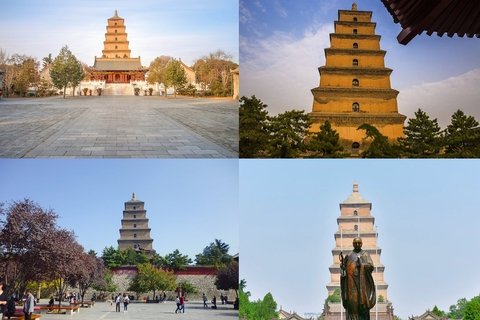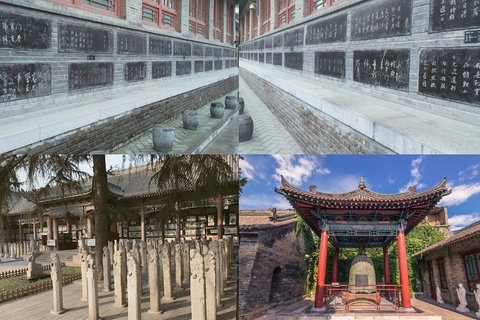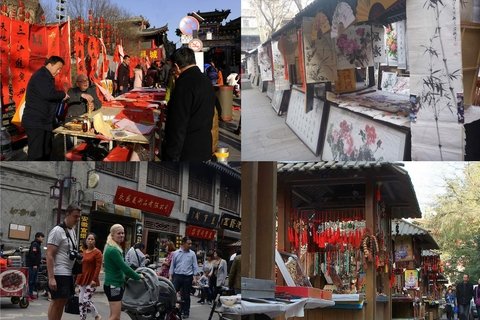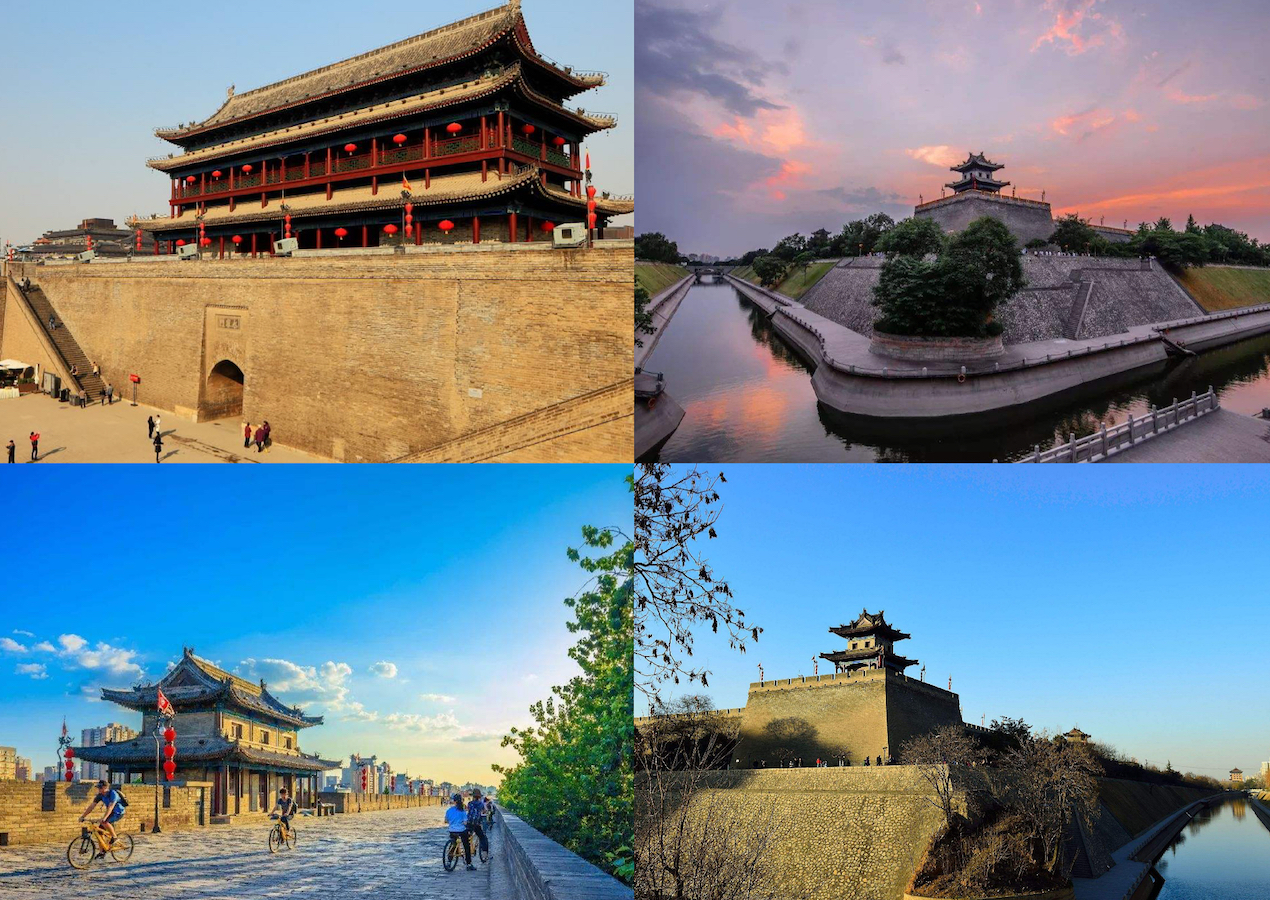The Complete Xi'an Travel Guide
Shaanxi Province's capital city Xi'an, known as "Chang'an" in ancient times, is located in central and western China. Experienced the rise and fall of 13 dynasties, Xi'an's every street and every corner reveals the historical foundation and legend. Designated by UNESCO in 1981 as a "World Historic City", Xi'an is one of the best tourist destinations for travelers who plan to tour China.
As one of the important birthplaces of Chinese civilization and the Chinese nation, and the starting point of the Silk Road, Xi'an's main treasure is the historical relics, from the world-famous Terracotta Warriors and Horses to the best-preserved City Wall, from the big & small wild goose pagodas to bell & drum towers, in addition, the towering and steep Mount Huashan is the best natural wonder surrounding Xi'an. Let's get started to explore the real Xi'an!

Top highlights in Xi'an
1. Terracotta Warriors and Horses
Hailed as "the eighth wonder of the world", the Terracotta Warriors is located in the pit 1.5 kilometers east of the Mausoleum of Qin Shihuang in Xi'an, which was discovered in March 1974.
In ancient times, the slave will be killed and buried as a burial object after the death of the slave owner. During BC 770-221, the terracotta figures (made of clay and wood) were substituted for human sacrifices in the tomb. As the largest ancient military museum in China, there are 3 pits of terracotta warriors and horses: No. 1 pit is the main phalanx of chariots and infantry, No. 2 pit is composed of chariots, cavalry, and crossbows, and No.3 pit is the command system of the military formation.

2. Xi'an City Wall
Built between 1374-1378 and expanded on the basis of the imperial city of Chang'an in the Tang Dynasty and Fengyuan City in the Yuan Dynasty, Xi'an City Wall is the most intact ancient Chinese city wall building with a total circumference of 11.9 kilometers.
The city wall has a complete military defense system including moats, suspension bridges, gate towers, arrow towers, main towers, turrets. To explore the city wall, visitors can either take a stroll or ride a bicycle.
3. Shaanxi History Museum
Located on the northwest side of Xi'an Giant Wild Goose Pagoda, it is China's first large-scale modern national museum. Its completion marks a new milestone in the development of Chinese museums. The museum condenses the historical essence of the Chinese nation and is an art palace that showcases ancient Chinese civilization and Shaanxi history and culture.
The museum has more than 370,000 cultural relics, ranging from simple stone tools of ancient people to various objects in social life before 1840. The time span is over one million years. Cultural relics are not only numerous and complete but also of high grade and wide value. It is also recognized as a world-class museum by UNESCO.


4. Giant Wild Goose Pagoda
The Giant Wild Goose Pagoda is located in the Dacien temple in the south of Xi'an, also known as the "Pagoda of Ci'en Temple". In AD 652, a Chinese Buddhist monk Xuanzang built the Giant Wild Goose Pagoda to preserve the Buddhist scriptures brought back to Chang'an (Xi'an) by the Tintu(Sindhu) Silk Road.
The Giant Wild Goose Pagoda is typical material evidence that the architectural form of ancient Indian Buddhist temples was introduced into the Central Plains with Buddhism and integrated into Chinese culture. It was as successfully included in the World Heritage List as a site on the "Silk Road" jointly applied for by China, Kazakhstan, and Kyrgyzstan.
5. Small Wild Goose Pagoda and Xi’an Museum
The Small Wild Goose Pagoda is located in the Xi'an Museum, facing the Big Wild Goose Pagoda from east to west. It was built in 707 to store Buddhist scriptures and Buddhist pictures brought back from Tintu(Sindhu) Silk Road. It was also included in the "World Heritage List" in 2014.
The small wild goose pagoda has a quiet environment. It has withstood the test of more than 1,200 years of wind and rain and more than 70 earthquakes. It has experienced three times separation and re-restoration in the past. There is still a huge iron bell cast in 1192, which is worth visiting.


6. Mountain Hua
Mount Hua, one of the five famous mountains in Chinese Han culture. To be precise, it does not belong to Xi'an. It is located in Huayin City, Weinan City, Shaanxi Province, but only 2 hours' drive from downtown Xi'an. Since it is relatively close to Xi'an, many tourists will put it on their itinerary in Xi'an. Mount Hua's altitude is 2,160 meters and famous for its odd dangers, and it is said to be "the most dangerous mountain in the world". There are also many historical sites in Mount Hua, including temples, pavilions, statues, and stone carvings everywhere. Travelers would need a full day to explore Mount Hua.
7. Forest of Stone Steles Museum
The Forest of Steles is located in the urban area of Xi'an. It is the museum with the earliest collection of ancient steles in China and the largest collection of famous steles - more than 11,000 pieces.
Xi’an Forest of Steles is a gathering place of not only ancient Chinese cultural classics but also famous calligraphy art treasures from the past. If you want to get a tattoo and are interested in Chinese calligraphy and Chinese characters, you may come here to find inspiration.


8. Bell Tower and Drum Tower in Xi'an
The Bell Tower and Drum Tower are located in the center of Xi'an. They are the iconic buildings of Xi'an. The two Ming Dynasty buildings echo each other and are spectacular.
The Bell Tower was first built in 1384 and later moved about 2 kilometers to its present site in 1582, thus becoming an axis building connecting the east and the west, echoing the North and south. Xi'an Drum Tower was built in 1380 AD, a little earlier than the construction time of the Bell Tower. It is also the largest existing drum tower in China.
9. Shuyuan Street
For travelers who are interested in traditional Chinese calligraphy and painting, Shuyuan Street is a perfect place for a visit. Besides, here you could buy souvenirs and taste authentic snacks. Compared with the bustling Muslim Street, it is quiet and with fewer tourists. Local people who love calligraphy and painting often come here to communicate.


10. Muslim Street
There is a Muslim gathering area in downtown Xi'an, which is composed of multiple roads, and the locals also call it a Muslim street. There are a dazzling array of snack shops, where you can feel the profound cultural heritage while tasting delicious food. There are also small shops selling souvenirs and handicrafts. This is the most crowded and lively place in Xi'an.
At an inconspicuous entrance of Muslim Street, there is a courtyard from the Ming and Qing Dynasties called the former residence of Gao Yuesong. Here you can find the architectural art of the Ming and Qing Dynasties, traditional house couplets, brick carving art, folk paper-cutting, shadow play, porcelain, etc.
11. Tang Paradise
Xi'an Tang Paradise is China's first large-scale royal garden-style cultural theme park that fully displays the style of the prosperous Tang Dynasty. Not only the palace in Tang Paradise but also the street market are also antique buildings. There are also the world’s largest outdoor aromatization project and the world’s largest water curtain movie performance.
The lights, fountains, and music are all here at night, making it more prosperous. We highly recommend travelers coming here to enjoy a night culture show.



Xi’an weather and Best time to travel
Xi'an has four distinct seasons. From March to May and September to November is the best time to visit Xi'an. Spring from March to May is warm, dry, and sunny. It is the flowering period, and you can see blooming scenes in many places. Autumn from September to November is cool and pleasant. The thousands-year-old ginkgos with golden leaves can be seen in many places. The sweet-scented osmanthus is all over the street. However, please note that it will rain at night most of the time.
In Summer from June to August, the temperature is high and the sun is scorching, occasionally reaching 40°C. It is recommended to wear sun hats, sunglasses and bring sunscreen and other sun protection products. Especially from mid-July to the end of August, when there are the most tourists in the year, hotel prices are also one of the most expensive periods of the year.
In Winter from November to February, the temperature in Xi'an is low, the wind is biting, and occasionally foggy. If you are lucky, you can appreciate the winter snow in this ancient capital. In addition, there are relatively fewer tourists during this period, and accommodation fees and tickets have been reduced compared to peak seasons.


How to get to Xi’an and travel around
1. Flight
The flight route covers all the provincial capital cities and major tourist cities in China. It also connects international and regional cities such as Tokyo, Singapore, Kuala Lumpur, Paris, Los Angeles, Sydney, etc. There are 8 airport bus routes, the ticket price is CN¥ 25 per person, and it takes about 1 hour to drive to the city center. The taxi fare from the airport to the city center is about CN¥ 80-100.
2. Train
Xi'an Railway is very developed, with three railway stations. Xi'an Station is located in the city center, and Xi'an North Station is a high-speed train station, which takes about 1 hour to downtown by car. The most convenient way to get from Beijing to Xi'an is to take the high-speed rail, which takes about 4.5 hours, and there are about 20 high-speed trains every day. Xi'an South Railway Station is the farthest from the city and has the fewest trains.
3. Travel around Xi’an
Xi'an highways are also well developed, and long-distance passenger stations in the city have opened many buses to cities and towns in the province as well as cities outside the province. In addition, when visiting Xi'an urban area, due to the rather convenient public transportation, taking subways, buses, and taxis are quite easy, of course, private cars through a local China travel agency is a better choice for family travel or big tourists group.

Recommended itineraries and tours in Xi'an
For Xi'an itself, we recommend travelers spending 2 to 3 days to cover the most highlights. Most travelers will choose Beijing as their first stop during their China tour, then continue to travel Xi'an by taking the high-speed train from Beijing, and travel further to other parts of China.
1. If you are quite fancy in Chinese Kung Fu, we suggest paying a visit to Shaolin Temple in Henan Province. It is the ancestral home of Chinese Zen Buddhism, a famous Buddhist temple in China, and the birthplace of Shaolin Martial arts. Here you can see the monks practicing martial arts and get the best experience of watching Chinese Kung Fu. Please read this 5 days Xi'an Luoyang ancient Chinese capital tour for more details.
2. For the first time travelers to make a tour to China, we highly recommend this 13 days Classic China tour to Beijing - Xi'an - Guilin - Shanghai. As travelers can not only visit the 2 most historical cities - Beijing and Xi'an, but also experience a wonderful natural scenery trip in Guilin and Yangshuo, and the journey will end in Shanghai where you can see modern China and the advanced lifestyle.

3. For history enthusiasts who are very interested in ancient Chinese history, this 10-days Beijing - Datong - Pingyao and Xi'an cultural tour would be a perfect match. Datong is a battleground for military strategists of all dynasties and is known as the"Key of the North". Here you will see magnificent grottoes, temples hanging on cliffs, and various relics of thousands of years of history. Pingyao is one of China's best surviving "four ancient cities", and its city walls are with a history of more than 2,700 years.
4. For travelers who want to start an adventure Tibet tour, Xi'an is a good start city. The flight from Xi'an to Lhasa is relatively cheaper than most cities in China, with a flight time of about 3.5 hours. Check out this 15 days China dreams with Tibet tour from Beijing, to combine a visit to Giant Panda's hometown Chengdu and the modern city Shanghai.

Accommodation and dining options in Xian
Accommodation
Except for the Terracotta Warriors and Mount Hua, Xi'an's main attractions are basically concentrated in the urban area. Drum Tower and Bell Tower District have a concentrated area of scenic spots and food, and transportation is also convenient. Most tourists choose to stay here.
For first-time visitors to China, it is highly recommended to stay in hotels with characteristics or antique buildings in urban areas. You will even feel that you travel through history and return to ancient China, which hundreds or thousands of years ago. Certainly, Xi’an also has many modern buildings, especially the appearance and facilities of the hotel are very modern and advanced.

Food
Xi’an’s cuisine is well-known all over China, mainly noodles and halal flavors. The most famous food street is mentioned above --- Muslim Street, which is very popular and you can taste a variety of food and snacks. The below delicacies can be found and eaten everywhere in Xi'an, and they are also the favorite of local citizens.
| Dish Name | Price Reference | Recommended Restaurants |
|---|---|---|
| Pita Bread Soaked in Lamb Soup | CN¥ 25-38 | 马洪小炒泡馍: No. 46, Hongbu Street, Lianhu District, Xi'an 老米家大雨泡馍: No.127, Xiyangshi, Beilin District, Lianhu District, Xi'an |
| Chinese Hamburger (Roujiamo) | CN¥ 10-15 | 樊记腊汁肉夹馍: No. 53, Zhubashi Street, Beilin District, Xi'an 秦豫肉夹馍: No.19, Dongmutoushi, Beilin District, Lianhu District, Xi'an |
| Biangbiang Noodles | CN¥ 15-28 | Biangbiang面: No. 80, Nanyuanmen, Beilin District, Xi'an 老李家Biangbiang面: No.99, Beiyuanmen, Lianhu District, Xi'an |
| Spicy Soup (Hulatang) | CN¥ 7-10 | 老刘家肉丸糊辣汤摊: No.85, Dapiyuan, Lianhu District, Xi'an 孙家肉丸胡辣汤: North Gate of Muslim Street, Beilin District, Xi'an |


Useful Travel Tips
- Except for the train stations and airport, there is a tourist information service center on the west side of the Drum Tower, which provides paperwork of multilingual tourist guides for free, and you can also check other tourist information.
- Xi'an belongs to the monsoon climate, and the winter is dry, please supplement with a proper amount of water every day.
- The Muslim snack street in Xi'an is a gathering place for the Muslims. They believe in Islam and enjoy halal food. Please respect the ethnic beliefs.
- Xi'an is an international tourist city with a large flow of people. Especially in the tourist season and public Chinese holidays, many attractions will limit the flow, you will also spend a long time in line or waiting.
- Mountain Hua is made of granite, and the roads are mostly stone steps. Please wear flat and comfortable shoes when hiking. It is best to bring a raincoat in the rainy season.
- Every summer vacation, the traffic of the Shaanxi History Museum will be overloaded. It takes 1-3 hours to line up outside the museum, so we suggest travelers take Xi'an Museum as an alternative. It is a museum integrating museums, historical sites, and urban gardens. Although the number of collections is less than that of the Shaanxi History Museum, the essence and highlights are covered.














